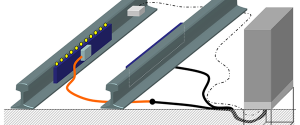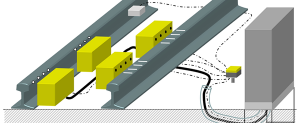Rail-wheel Lubrication
Rail and wheel wear can be reduced dramatically by proper lubrication. In addition, lubrication can help in saving energy and reducing noise. Rail-wheel lubrications applies by automaticly or manually.
Advantages of automatic lubrication;
- Maintenance benefits
• Reduces labour costs
• Extends repair intervals
• Reduces lubricant consumption - Operational benefits
• Increases equipment reliability
• Reduces unplanned downtime
• Reduces energy and fuel consumption
• Improves equipment profitability - Safety benefits
• Eliminates manual lubrication
• of difficult-to-access points
• Reduces the risk of derailments - Environmental benefits
• Reduces noise
• Eliminates over-lubrication
There are three lubrication methods in use by railways around the world: wayside, on-board and hi-rail lubrication. Wayside lubrication is one of the most widely used methods. This research reviews the following important factors: the lubricator equipment technology, the installation location, the grease, the climatic conditions, and the setup of the grease dispensing rate for the train traffic and the placement of successive wayside units along the track.
Wear is a result of friction between the wheels and rails. Gauge side wear on the high rails of sharper curves is a common problem. Wear affects the life and performance of rails and wheels. The influential wear factors are: axle loads, lateral forces, longitudinal force, creepage, curve radius, gradient of the track, cant/superelevation, track gauge, surface conditions of the wheels and the rails, train speed, train length, frequency and type of trains, rolling stock performance, and operational and environmental issues.
1- Wayside Lubrication System
This systems apply for gauge face, top-of-rail and restraining rail conditioning. Wayside lubrication systems effectively apply a consistent and controlled volume of lubricant to the rail and hold that grease or friction modifier in place, allowing the wheels to grab and carry it around the track curve. In wayside lubrication systems passing trains are detected by track-mounted wheel sensors. The applied lubricant is picked up by passing wheels, which carry the lubricant through the up-coming curve(s).
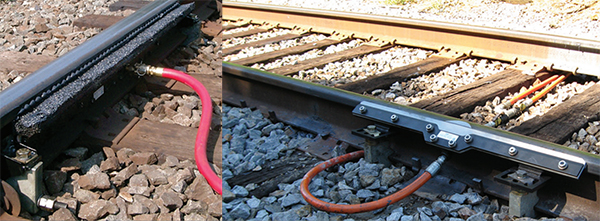
High-pressure, low-volume pumps effectively cover the rail with just enough lubricant, minimizing pollution. Drilled lubrication holes or applicators serve which get clamped to the rail, system enable exact metering of grease. It helps to ensure each lube port receives the same small amount of grease every time, automatically. The systems are capable of pumping long distances, as well as high-viscosity lubricants. Dual-track systems and customized solutions are available.
Wayside Lubrication System with Wiper Bar
Wayside Lubrication System with Injection Device
Wayside Lubrication System with Drilled Channels
Advantages:
- Free track survey to pinpoint trouble spots
- “No-clog” lubrication via high-pressure pumps
- Exact metering of grease
- Cost-effective, combined gauge face and top-of-rail
system layouts possible
2- On-board Lubrication Systems
This systems for wheel flange lubrication and railhead conditioning are mounted on-board on the first leading vehicle axle. There are two lubricant used in on-board lubrication system; grease and solid stick.
a. Spray (grease) System; It is commonly used in Europe. It is available fine tuned control and single application per train. The system can control and manage with a control unit including an integrated curve sensor or TCMS (Train Control Monitoring System). When system activated, air and lubricant are fed from grease tank to the spray nozzle. The lubricant is sprayed to the Wheel flange in a thin layer and transferred to the gauge face of the rail by direct contact. It is available for vehicles without on-board air supply.

b. Solid Stick System; Train mounted solid stick in which a stick of lubricant is spring loaded against the wheel flange has following advantages:
- Continuous application
- Precise application ‐ no lubricant migration to TOR
- Simple, reliable, low maintenance requirements
- Clean, non‐toxic, non‐flammable
- Proven track record
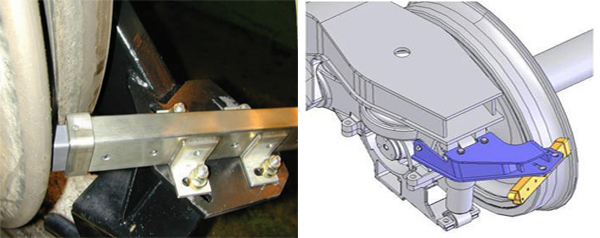
Advantages of on-board lubrication system over wayside lubrication system;
- reduced safety risk exposure of staff during installation, inspection and maintenance.
- easier inspection and maintenance (carried out in more controlled conditions).
- the rail will contunie to receive some friction control protection in the event of the failure of an individual on board lubricator.
3- Hi-rail Lubrication
Hi-rail lubrication systems use a specially designed mobile truck for grease application from the nozzle, as a thin bead along the rail gauge face.
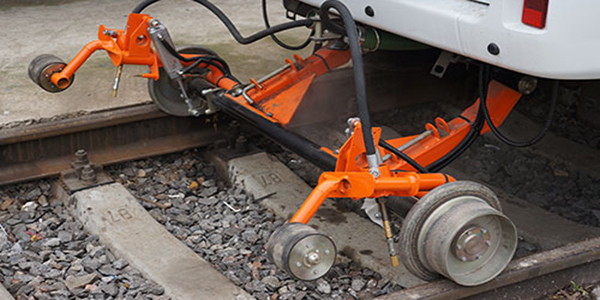
Sources; skf.com; netirail.eu; Handbook of Railway Vehicle Dynamics
Videos;

